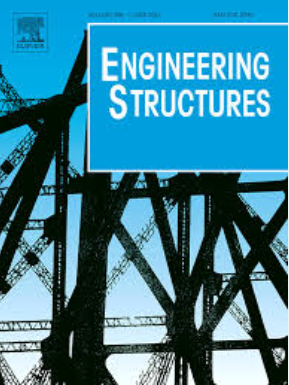Tensile behaviour of swift-constructed demountable blind bolted T-stub to hollow section column connection
IF 6.4
1区 工程技术
Q1 ENGINEERING, CIVIL
引用次数: 0
Abstract
Recently, a new type of blind bolt is proposed, named Swift-Constructed Demountable Blind Bolt (SCDBB). Studies have been conducted for its development process and bolt behaviour at the component level. Nevertheless, there is still a lack of research on the structural behaviour of SCDBB when applied to hollow section column connections. In addition, as the vital “component” in connection, investigating the tensile behaviour of T-stub to column connection is worthy for a novel bolt. Thereby, this paper carried out an experimental and theoretical investigation for SCDBB T-stub connections. Two types of major tests were conducted, comprising the bolt comparison test and the SCDBB connection test. Corresponding research purposes can be consequently revealed as two aspects, on the one hand, to compare the structural performance of SCDBB with other existing bolt products; on the other hand, to study the tensile behaviour of SCDBB T-stub connection with various geometric parameters. Experimental programme, observations, test results with relevant discussions, and the theoretical approaches, are explained and depicted successively. Test results indicate that compared with other blind bolts, SCDBB can be regarded as a blind bolt product with more comprehensive and excellent performance. In addition, two typical failure modes and three key moments of SCDBB connections are revealed. Under the failure mode of column wall yielding with elastic expansion nut buckling, design value of the connection tensile resistance should adopt the yield strength instead of the ultimate resistance of connection. While under the failure mode of bolt shank fracture, the design value of connection tensile resistance can simply employ the sum of the relevant design values of bolt shanks. Based on the test results and extended finite element (FE) results, corresponding modified analytical models and theoretical formulae with high prediction accuracy are suggested for the SCDBB connection.
快速构造可拆卸盲栓t形短段与空心截面柱连接的拉伸性能
近年来,提出了一种新型盲螺栓,称为快速构造可拆卸盲螺栓(SCDBB)。在构件水平上对其开发过程和锚杆性能进行了研究。然而,对于SCDBB应用于空心截面柱连接时的结构性能,目前还缺乏研究。此外,作为连接中至关重要的“部件”,研究t形短杆与柱连接的抗拉性能对新型螺栓的开发具有重要意义。因此,本文对SCDBB t型存根连接进行了实验和理论研究。主要进行了两种类型的试验,包括螺栓对比试验和SCDBB连接试验。因此,相应的研究目的可以揭示为两个方面:一方面,将SCDBB与其他现有锚杆产品的结构性能进行比较;另一方面,研究了不同几何参数下SCDBB T-stub连接的拉伸性能。实验程序、观察结果、相关讨论的测试结果以及理论方法,依次进行了解释和描述。试验结果表明,与其他盲螺栓相比,SCDBB可视为一种性能更全面、更优良的盲螺栓产品。此外,还揭示了SCDBB连接的两种典型破坏模式和三个关键时刻。在弹性膨胀螺母屈曲的柱壁屈服破坏模式下,连接件抗拉设计值应采用屈服强度,而不是连接件的极限抗拉。而在螺栓杆断裂破坏模式下,连接抗拉设计值可简单取螺栓杆相关设计值之和。根据试验结果和扩展有限元结果,提出了相应的修正解析模型和具有较高预测精度的理论公式。
本文章由计算机程序翻译,如有差异,请以英文原文为准。
求助全文
约1分钟内获得全文
求助全文
来源期刊

Engineering Structures
工程技术-工程:土木
CiteScore
10.20
自引率
14.50%
发文量
1385
审稿时长
67 days
期刊介绍:
Engineering Structures provides a forum for a broad blend of scientific and technical papers to reflect the evolving needs of the structural engineering and structural mechanics communities. Particularly welcome are contributions dealing with applications of structural engineering and mechanics principles in all areas of technology. The journal aspires to a broad and integrated coverage of the effects of dynamic loadings and of the modelling techniques whereby the structural response to these loadings may be computed.
The scope of Engineering Structures encompasses, but is not restricted to, the following areas: infrastructure engineering; earthquake engineering; structure-fluid-soil interaction; wind engineering; fire engineering; blast engineering; structural reliability/stability; life assessment/integrity; structural health monitoring; multi-hazard engineering; structural dynamics; optimization; expert systems; experimental modelling; performance-based design; multiscale analysis; value engineering.
Topics of interest include: tall buildings; innovative structures; environmentally responsive structures; bridges; stadiums; commercial and public buildings; transmission towers; television and telecommunication masts; foldable structures; cooling towers; plates and shells; suspension structures; protective structures; smart structures; nuclear reactors; dams; pressure vessels; pipelines; tunnels.
Engineering Structures also publishes review articles, short communications and discussions, book reviews, and a diary on international events related to any aspect of structural engineering.
 求助内容:
求助内容: 应助结果提醒方式:
应助结果提醒方式:


